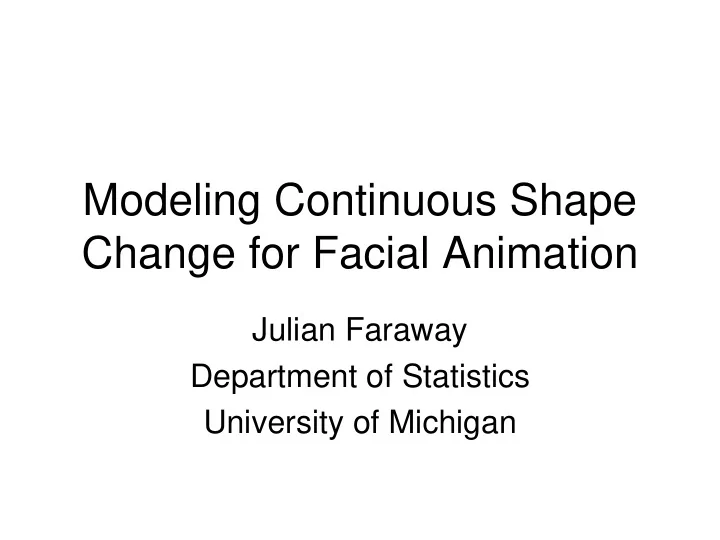

Modeling Continuous Shape Change for Facial Animation Julian Faraway Department of Statistics University of Michigan
Cleft Lip and Palate A B C Sequence of surgeries is recommended. Cleft lip surgery at 3 months and palate surgery around 1 year. Surgery often continues into adolescence.
Cleft lip facts • Common birth defect – about 1 in 1000 births • More common in males, Asians and Hispanics • Links to folic acid, smoking/drinking ??? • Heterogenous • Some genetic linkage
Surgical Decisions • Repair requires a sequence of surgeries • Each surgery tends to improve static aesthetic appearance • Too much surgery can degrade facial function • Surgeons/Parents tend to be biased towards aesthetics • Need objective measures of facial function
Example of Cleft Motion
Capturing Facial Motion
Marker Placement 2 6 5 3 1 7 10 9 13 14 12 11 15 16
Standard motions
Data • Each motion represented by – 38 markers – 3 dimensions – 240 frames of motion • How can we reduce this very large amount of data to a few numbers that capture the essence of the motion? • Large number of motions – normal and cleft subjects, smiles, grimaces etc, change over time, different studies etc
Relative Motion from Rest • For each pair of markers i and j we compute the d ij ( t ) distance over time t as • Now compute the relative change as d ( t ) = − ij r ( t ) 1 ij d ( 0 ) ij which is invariant to whole head motion, facial shape and variability in marker placement
Reconstructing the Motion • Given relative change and static face r ( t ) d ( 0 ) ij ij • Can compute d ij ( t ) • Can use multidimensional scaling to recover the coordinates of the markers at time t up to location, rotation and reflection • Align successive frames based on almost fixed markers on the nose • What if a different static face is used or the components of the relative motion are modified?
Projecting onto 3D Motion d ij ( t ) • Some predicted may not correspond to 3D objects • Multidimensional scaling projects to the closest representation in 3D • Useful because – Interested in motion projected onto different faces – Interested in averaging relative changes across different motions • Works because faces are similar etc.
Partitioning the Motion • Motion consists of five phases • Rest, go to pose, hold, return from pose, resume rest • Many different pairwise distances
Selecting the cutpoints • Best distances for cutting vary between and within motions and individuals • Algorithm determines a weighted average of inter-marker distances that focuses on the particular motion • Cut points are determined by another algorithm and manually confirmed • Example of a “registration” problem
B-spline modeling r t ( ) • Each is fit with a cubic B-spline with 16 ij basis functions
B-Spline Coefficients • Because there are 38 markers and all pairwise are considered, this results in a total of 11248 spline coefficients for each motion • Allows statistics on a group of motions – for example, the coefficients can be averaged • Given the coefficients, a facial motion can be reconstructed using multidimensional scaling
Principal Components • Form the coefficients for all motions of a given animation into a, say, 120x11248 if there are 120 motions • Compute the Principal Components • Most of the variation in the first few directions • PC directions represent axes of greatest motion – these can be displayed
PC scores • Principal component scores for each motion represent the component of that particular motion in the direction of the given principal component • These scores can be analyzed using such standard statistical methods as linear mixed models • Can test for differences or trends in groups • Can identify unusual motions
Summary • Reduce complex (many numbers) facial motion to simple (1-3 numbers) principal component scores • Do standard statistics on the scores • Must visualize motion to understand the scale (PC direction) of the scores
More Information • Work is joint with Dr. Carroll-Ann Trotman, School of Dentistry, University of North Carolina • Papers, software available from my web site
Recommend
More recommend